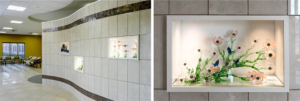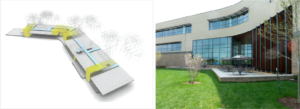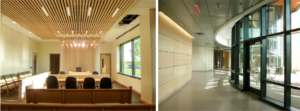Using Biophilic Building Design to Improve Patient Outcomes
-
Category
Studio-Healthcare, Innovation -
Posted By
Schmidt Associates -
Posted On
Apr 21, 2021
Whether it’s home, work, school, or elsewhere, we spend more than 90 percent of our time indoors today. When everything from the furniture we sit on to the sources of our light are artificial, it is easy to lose the connection to the natural world that we need as human beings. This can have a variety of effects on both our mental and physical health.
For decades, architects and interior designers have worked to create a more a natural look and feel to the built environment to regain some of that natural connection. Not only is nature beautiful and a source of inspiration, but it’s also good for us.
We call this innate connection of humans to nature “biophilia.” Biophilic design is the practice of bringing nature and natural elements into the built environment.
Nature and Healing
Bringing nature indoors has been shown to have a positive impact on a variety of aspects of health. Not only can it improve mood, but it can also positively affect heart rate and blood pressure, reduce stress hormones, and improve circadian system function. This goes for patients as well as clinical and other staff.
Further, biophilic design can be connected to improved patient outcomes in healthcare settings. Evidence shows that views of natural elements, or even imagery of nature, can mitigate pain and create the potential for accelerated recovery rates.
Dozens of studies support this connection. One of the first was research by Roger Ullrich. He showed a 0.8-day reduction in recovery times when patients recovering from gall bladder surgery were exposed to natural scenes versus brick hospital room walls.
Reducing the average hospital stay by mere hours could save thousands of dollars per patient. Terrapin Bright Green projects that reducing the average length of stay in hospitals by less than half a day can amount to more than $90 million in reduced hospital costs annually.
Implementing Biophilic Design Principles in Healthcare Facilities
How do you create these connections to nature in healthcare facilities designed for efficiency and sterility?
Researchers have broken down the biophilic experience into three parts, all of which can be adapted for healthcare environments:
- Nature in the Space
- Nature of the Space
- Natural Analogues
Nature in the Space
This component of biophilic design relies on direct connections with natural elements. It encompasses things like plant life, water, and animals to the sounds and scents of the ecosystem.
In interior design, this can be expressed through elements like healing gardens, plantscapes, water features, aquariums, or green walls. These features can be good additions to common spaces, cafeterias, and waiting areas.

Jewish Hospital Med Center South
Nature of the Space
This theme entails creating intentional and engaging spatial arrangements that capture the dynamics of being in nature. This includes unhindered views across distances, places to take refuge from environmental stimuli, and spaces that lead people to venture further into the environment.
We can adjust a building’s orientation and placement of windows to maximize natural light’s penetration into each floorplate and create views to the outdoors. For example, at Eastern State Hospital we utilized stair towers connecting the upper levels to flood natural light into internal lobbies for patients and visitors. Rather than windowless stair towers with minimal finishes, the towers helped create friendly, bright and inviting spaces that staff and patients want to use.

Eastern State Hospital Daylighting Opportunity Diagram and Courtyard
Natural Analogues
Natural analogues provide indirect references to nature. This can be achieved with design elements that mimic nature, such as botanical patterns and prints, furniture that evokes organic shapes, vinyl flooring that mimics wood, or engineered quartz made to imitate marble or stone. These features can be implemented in patient rooms, waiting areas, corridors, and a variety of spaces throughout a facility.

Eastern State Hospital







